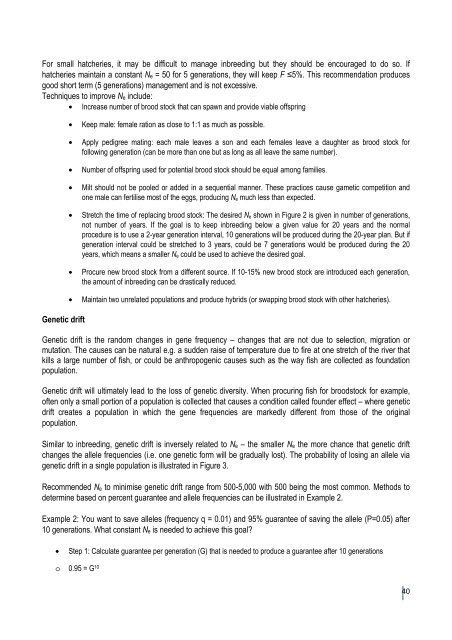Training of Trainers - Library - Network of Aquaculture Centres in ...
Training of Trainers - Library - Network of Aquaculture Centres in ...
Training of Trainers - Library - Network of Aquaculture Centres in ...
- No tags were found...
Create successful ePaper yourself
Turn your PDF publications into a flip-book with our unique Google optimized e-Paper software.
For small hatcheries, it may be difficult to manage <strong>in</strong>breed<strong>in</strong>g but they should be encouraged to do so. Ifhatcheries ma<strong>in</strong>ta<strong>in</strong> a constant Ne = 50 for 5 generations, they will keep F ≤5%. This recommendation producesgood short term (5 generations) management and is not excessive.Techniques to improve Ne <strong>in</strong>clude:• Increase number <strong>of</strong> brood stock that can spawn and provide viable <strong>of</strong>fspr<strong>in</strong>gGenetic drift• Keep male: female ration as close to 1:1 as much as possible.• Apply pedigree mat<strong>in</strong>g: each male leaves a son and each females leave a daughter as brood stock forfollow<strong>in</strong>g generation (can be more than one but as long as all leave the same number).• Number <strong>of</strong> <strong>of</strong>fspr<strong>in</strong>g used for potential brood stock should be equal among families.• Milt should not be pooled or added <strong>in</strong> a sequential manner. These practices cause gametic competition andone male can fertilise most <strong>of</strong> the eggs, produc<strong>in</strong>g N e much less than expected.• Stretch the time <strong>of</strong> replac<strong>in</strong>g brood stock: The desired N e shown <strong>in</strong> Figure 2 is given <strong>in</strong> number <strong>of</strong> generations,not number <strong>of</strong> years. If the goal is to keep <strong>in</strong>breed<strong>in</strong>g below a given value for 20 years and the normalprocedure is to use a 2-year generation <strong>in</strong>terval, 10 generations will be produced dur<strong>in</strong>g the 20-year plan. But ifgeneration <strong>in</strong>terval could be stretched to 3 years, could be 7 generations would be produced dur<strong>in</strong>g the 20years, which means a smaller N e could be used to achieve the desired goal.• Procure new brood stock from a different source. If 10-15% new brood stock are <strong>in</strong>troduced each generation,the amount <strong>of</strong> <strong>in</strong>breed<strong>in</strong>g can be drastically reduced.• Ma<strong>in</strong>ta<strong>in</strong> two unrelated populations and produce hybrids (or swapp<strong>in</strong>g brood stock with other hatcheries).Genetic drift is the random changes <strong>in</strong> gene frequency – changes that are not due to selection, migration ormutation. The causes can be natural e.g. a sudden raise <strong>of</strong> temperature due to fire at one stretch <strong>of</strong> the river thatkills a large number <strong>of</strong> fish, or could be anthropogenic causes such as the way fish are collected as foundationpopulation.Genetic drift will ultimately lead to the loss <strong>of</strong> genetic diversity. When procur<strong>in</strong>g fish for broodstock for example,<strong>of</strong>ten only a small portion <strong>of</strong> a population is collected that causes a condition called founder effect – where geneticdrift creates a population <strong>in</strong> which the gene frequencies are markedly different from those <strong>of</strong> the orig<strong>in</strong>alpopulation.Similar to <strong>in</strong>breed<strong>in</strong>g, genetic drift is <strong>in</strong>versely related to Ne – the smaller Ne the more chance that genetic driftchanges the allele frequencies (i.e. one genetic form will be gradually lost). The probability <strong>of</strong> los<strong>in</strong>g an allele viagenetic drift <strong>in</strong> a s<strong>in</strong>gle population is illustrated <strong>in</strong> Figure 3.Recommended N e to m<strong>in</strong>imise genetic drift range from 500-5,000 with 500 be<strong>in</strong>g the most common. Methods todeterm<strong>in</strong>e based on percent guarantee and allele frequencies can be illustrated <strong>in</strong> Example 2.Example 2: You want to save alleles (frequency q = 0.01) and 95% guarantee <strong>of</strong> sav<strong>in</strong>g the allele (P=0.05) after10 generations. What constant Ne is needed to achieve this goal?• Step 1: Calculate guarantee per generation (G) that is needed to produce a guarantee after 10 generationso 0.95 = G 1040
















